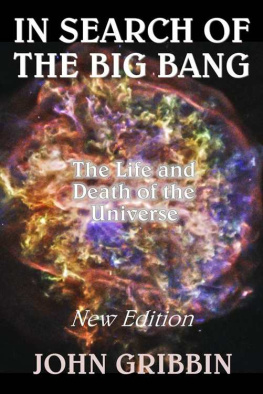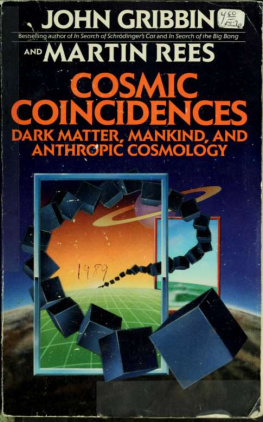John Gribbin - In the Beginning: After Cobe and Before the Big Bang
Here you can read online John Gribbin - In the Beginning: After Cobe and Before the Big Bang full text of the book (entire story) in english for free. Download pdf and epub, get meaning, cover and reviews about this ebook. year: 2017, publisher: Endeavour Press, genre: Religion. Description of the work, (preface) as well as reviews are available. Best literature library LitArk.com created for fans of good reading and offers a wide selection of genres:
Romance novel
Science fiction
Adventure
Detective
Science
History
Home and family
Prose
Art
Politics
Computer
Non-fiction
Religion
Business
Children
Humor
Choose a favorite category and find really read worthwhile books. Enjoy immersion in the world of imagination, feel the emotions of the characters or learn something new for yourself, make an fascinating discovery.
- Book:In the Beginning: After Cobe and Before the Big Bang
- Author:
- Publisher:Endeavour Press
- Genre:
- Year:2017
- Rating:5 / 5
- Favourites:Add to favourites
- Your mark:
In the Beginning: After Cobe and Before the Big Bang: summary, description and annotation
We offer to read an annotation, description, summary or preface (depends on what the author of the book "In the Beginning: After Cobe and Before the Big Bang" wrote himself). If you haven't found the necessary information about the book — write in the comments, we will try to find it.
Dr. John Gribbin proposes that we take a different look at our understanding of the universe: that the Universe itself can be regarded as a living entity that has evolved through Darwinian selection.
Gribbin draws on the latest measurements of the Universe through the COBE satellite and our current understanding of the Big Bang to address the questions of how and why the Universe came into being, and what its future evolution holds in store.
The COBE provided evidence of the long-theorized ripples in the fabric of spacetime (brief fluctuations in microwave radiation still echoing from the first trillionth of a second after the cataclysmic birth of creation), which prompted Gribbin to explore the significance of this discovery and synthesize his proposed theory of the Universe.
Though controversial, his portrait gives us a glimpse of the Universes first birth pangs, the nature of life and the way evolution works, the geography of the Universe and all it contains, and the way in which the black hole bounce enables the Universe to reproduce itself.
Along the way we learn why the laws of physics should be as they are and whether human beings have a special place in the living Universe.
His analysis unravels the riddle of anthropic cosmology, the vision of the Universe as a product of evolution by natural selection, echoing and extending the Gaia principle that all the living things on earth form an interlocking web which can be regarded as a single living organism.
Gribbin also contends that whole galaxies of stars, like our own Milky Way system, can be seen to possess properties usually associated with living systems and to show signs of evolution.
Dr. John Gribbin trained as an astrophysicist at Cambridge before becoming a full-time science writer.
He is the author of over thirty books, including the bestselling In Search of Schrodingers Cat, Unveiling the Edge of Time, and, with Michael White, Stephen Hawking.
Praise for Dr John GribbinOne of the finest and most prolific writers of popular science around - *The Spectator*
John Gribbinstudied physics at the University of Sussex and went on to complete an MSc in Astronomy at the same University before moving to the Institute of Astronomy in Cambridge, to work for his PhD. After working for the journal Nature and New Scientist, he has concentrated chiefly on writing books. His books have received science-writing awards both in the UK and the US. Since 1993, Gribbin has been a Visiting Fellow in Astronomy at the University of Sussex, chiefly working on the problem of determining the age of the Universe.
**
John Gribbin: author's other books
Who wrote In the Beginning: After Cobe and Before the Big Bang? Find out the surname, the name of the author of the book and a list of all author's works by series.











